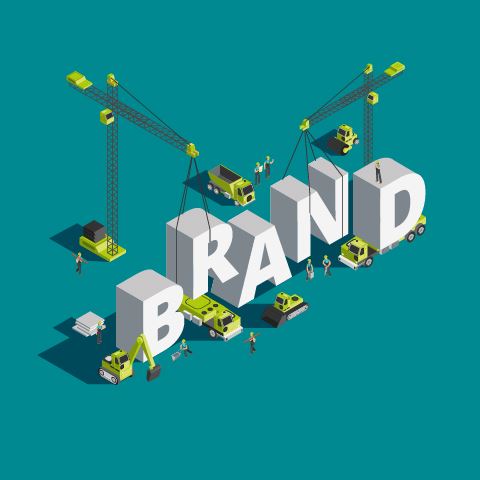
Navigating the rise of technology in construction
In this article we’ll dive into the booming world of smart construction technology, exploring the innovations driving the change and what the future looks like for the industry.

First things first, what is ‘brand’? It seems a simple enough question, but ‘brand’ is a widely used word that’s often misunderstood. It stretches way beyond logos, templates and taglines.
Your brand is your biggest unique differentiator. It defines how your customers think of you and what they should expect from your company. It’s a way of distinguishing yourself from your competitors and clarifying what it is that makes your business a better choice. Put simply, it’s what makes you, you.
Pretty important, right? But too often businesses don’t properly invest in their brands. They sacrifice long-term sustainability for short-term sales activation, forgetting that short-term activity becomes increasingly ineffective without long-term strategy underpinning it.
In this article we'll walk you through what ‘brand’ really means, why it’s important, and how you can build your brand and maintain its longevity.
The power of branding is its ability to influence behaviour. Companies are branded so that they can build reputations and a good reputation elicits more trust, loyalty, advocacy and ultimately, purchases.
Let’s use an example. Red Bull is an energy drink and usually the most expensive one in the shop. We can’t exactly prize it for its taste, either. In fact, the company even seemed to poke fun at itself in a previous advertising campaign for not tasting great.
Today, Red Bull sells around seven billion cans every year with a net worth of £10bn. In the process it’s become almost as synonymous with sports, music and stunts, as it has with energy drinks.
How did they do it? They focused on creating a brand that embodies a distinct lifestyle and audience rather than selling cans of Red Bull. It’s a company credited with not only creating an energy drink but starting an entire market. And in doing so, it created a philosophy and a way of behaving connected to the idea of ‘giving wings’ to its customers.
The key takeaway is that having a consistent brand, recognisable culture and distinct values will build a clientele that’s much more loyal to you than if they were to just sign up for the price point. People invest in brands for the long-term acquisition in loyalty and will come to your business for the attributes they instantly associate with it. Then, and only then, can you look at commanding a more premium price.
Define your mission statement
The first step in any B2B branding project should be to outline your business’s vision, core values and mission statement.
For example, Amazon’s mission statement is “to be Earth’s most customer-centric company, where customers can find and discover anything they might want to buy online, and endeavours to offer its customers the lowest possible prices.” This leaves absolutely no doubt as to the company’s vision and what value it offers its customers.
Determine your value proposition
Ask yourself: why should someone buy your products or services? Identify what your company provides that differentiates it from your competition and addresses a pain point for your customers.
Tell your story
Build your brand narrative (sometimes referred to as ‘messaging’), make it memorable, and align it with your business strategy. The fastest-growing B2B businesses, like Salesforce and XPO Logistics, have defined their business around the benefits they provide to customers, not the products and services they offer. Your brand should be tailor-made for your company’s mission. And remember: by crafting an interesting and engaging brand narrative, you’ll educate your customer base without them ever thinking they’re even being sold to.
A brand isn’t built in a day
Cultivating an engaging and consistent image takes years of sustained effort and investment. Invest in it properly and you’ll reap the benefits for years to come.
How a company acts will always trump what it says
You need to talk the talk and walk the walk. Be consistent and true to your brand in everything you do. It’s what defines your company – live and breathe it, day in day out.
Short-term activation vs long-term sustainability
We get it, your business needs quick results. But it takes time to create lasting business impact. While investing in short-to-medium term campaigns is important, they’ll fall down without a solid long-term brand building strategy in place. A balance needs to be struck.
B2B marketing research suggests a 50/50 split between short and long-term activity. Some even suggests 60/40 in favour of long-term. Tellingly, in a survey of 600 B2B marketers, those who have outperformed their competition in the last two years are twice as likely to think long-term.
Capture hearts and minds
It’s often said that people buy with emotion and justify it with logic. This can be just as true in the B2B world as it is in the B2C one. Build a brand and achieve engagement by capturing hearts and minds. B2B brand building doesn’t have to be boring – behind every great B2B brand is memorable, stand-out creativity.
Promote your brand internally
The final step is to get company-wide buy-in. How your company communicates externally counts for little if your internal staff don’t understand or even know about your brand. In some way, each member of your company is a brand ambassador. Share your vision with them and do it with excitement to create an internal buzz and show employees that they have a stake in the company’s success.
Maintaining longevity
The points above should act as your foundation when building your brand. But whether you’re a year-old start-up or 100-year-old blue chip, they should be regularly revisited and reevaluated.
Establishing your brand and maintaining it are very different things. No brand can remain exactly the same for decades. Some brands come and go while others stand the test of time – and the ones that win out do so because they evolve. Brand evolution represents a response to customer feedback, changing trends and marketplaces. It allows businesses to remain current and reactive to the wants of its customers.
As part of their evolution, brands should consider…
Thinking of their brand in new ways
This includes redefining what a product and/or service is or could be. Think back to our Red Bull example and how they branched out into sports, stunts and music.
Redefining their target audience
If your current audience has begun valuing your company less, you may want to consider other groups who may be able to use your services in a new way that enables your business to regain value.
Changing what their brand/service looks like
Sometimes changing the value of a product/service can be a s simple as changing how it appears to others.
Wrapping a different story around their brand
New storylines can change how people perceive or view a brand or product. And increasingly there are opportunities to link products/services to stories around environment, conduct, purpose, and cause.
But what they won’t be doing is changing their original core values. The evolution of your brand should remain aligned with your business’s original values – values that it must continue to promise and keep. Regardless of how old they are, these values will only become stale if you no longer believe in them.
If that’s the case, then a wholesale rebrand, rather than brand evolution, is likely what your business needs. A rebrand is a clear signal that your business, customers and/or product/service has significantly changed.
Investing in your brand is non-negotiable. It’s a must. With the marketing landscape and your customers’ expectations shifting quicker than ever before, you need to be constantly evaluating and investing in your brand.
Your work to build a long-term, sustainable brand identity may not give you instant results, but if it’s done consistently, it will yield long-term benefits and increased customer loyalty. And loyalty’s important – it establishes an emotional connection with your customer base and ultimately, makes your business more effective.
It’s easy to err on the side of short-termism, and while short-to-medium term campaigns have a role to play in spiking interest and sales, remember to play the long game and keep an eye on the bigger picture.
Consistency is key. This is achieved through the hard work upfront to establish your value proposition and brand narrative. A consistent and engaging brand identity will give you the impression of reliability and quality – two attributes that will encourage customers to come back time and again.
Need help building your business’s brand? Contact Director, Rachel Arquati: +44(0)1285 626000 / r.arquati@clearb2b.com.



In this article we’ll dive into the booming world of smart construction technology, exploring the innovations driving the change and what the future looks like for the industry.

Learn how to use presentation opportunities as an effective lead-generation tool in your trade show activity.

Great marketing success comes from keeping your communications focused, engaging and simple to ‘get’ - but that isn’t always so simple to achieve.

With multiple types of technologies being considered, we bring you a snapshot of alternative fuels and review the most prominent pros and cons for each one.